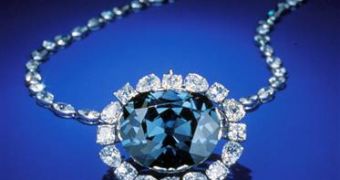Well, for an average person to tell the difference between a diamond and an inexpensive cubic zirconia crystal is pretty easy, as the cubic zirconia quickly loses its luster. However, while dealing with a real diamond and a synthetic one, the identification process could prove to be a challenge taking into consideration the fact that most of us never held a real diamond in our hand, and probably never will. Professional trained jewelers use specialized equipment to evaluate the 4 C's of a diamond crystal: clarity, cut, color and carat weight.
Nevertheless, even the keen eye of an experienced jeweler could be fooled by artificial crystals, synthesized through modern crystal growth techniques. While shined with ultraviolet light, the world famous Hope Diamond seems to give off an eerie red glow, fact that could reveal a new method of testing for fake diamonds.
As they are forged in extreme pressure and temperature conditions deep in the core of our planet, it is natural that the diamonds contain a certain level of impurities. According to Jefferey Port, curator of the National Gem Collection at the Smithsonian's National Museum of Natural History, the Hope Diamond appears as a blue crystal under white light, while the red luminescent glow is given off by boron impurities inside the diamond.
Albeit the Hope Diamond is the only blue diamond known to glow red under the action of the ultraviolet light, as all other blue crystals shine in blue. This unique property is given by the different ratios between the boron and nitrogen impurities included in the diamond.
Port argues that this method can be successfully used to identify real diamonds from the fake ones, by measuring the different glows of light given off by blue crystals, while subjected to ultraviolet light. The Hope Diamond is a large deep blue diamond, 45.5 carat in weight, housed by the Smithsonian Natural History Museum. It is legendary for the supposed curse it casts on all those who possess it. The original crystal out of which the diamond was cut was mined from the Kollur mine in India.
However, the clear history of the diamond is rather mysterious, so, if the diamond was indeed extracted from India, it could be identified by comparing it with other stones mined from Kollur. Port would like the rock to be displayed at the museum in ultraviolet lights, but the illuminating conditions disable the possibility. Instead, he stated that the museum would like to create a video of the diamond under UV-light to show it glowing red, process which continues for a brief period of time after the ultraviolet source is being removed.
The extremely rare blue diamonds have been mostly studied through scientific research on synthetic diamonds in order to determine their phosphorescent properties.

 14 DAY TRIAL //
14 DAY TRIAL //